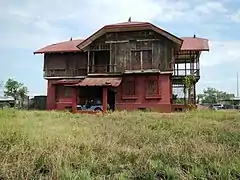Bahay na Pula
The Bahay na Pula (Tagalog for "Red House") is a former hacienda in San Ildefonso, Bulacan in the Philippines. The site is mostly remembered for its usage as a Japanese garrison. When they took ownership of the building the Japanese military murdered hundreds of suspected guerillas. Hundreds of women were also raped by soldiers at this site sometimes repeatedly.
| Bahay na Pula | |
|---|---|
Bahay na Pula (Filipino) | |
 The building in 2014 | |
| Alternative names | The Red House |
| General information | |
| Status | Dilapidated |
| Town or city | San Ildefonso |
| Country | Philippines |
| Completed | 1929 |
| Demolished | 2016 (partially) |
| Owner | Ilusorio family |
| Technical details | |
| Material | wood |
| Floor count | 2 |
| Known for | Japanese garrison during World War II |
Part of a series on the |
|---|
| History of the Philippines |
 |
| Timeline |
| Archaeology |
|
|
History
It was constructed in 1929 at Barangay Anyantam under the orders of Don Ramon Ilusorio of the Ilusorio family, who owned vast hacienda lands in the area. as a family mansion with two storeys.[1] It was made largely out of wood and painted red on the outside, giving it its name. The house was surrounded by large gardens filled with tamarind, camachile, and duhat trees.
During the Japanese occupation of the Philippines, on November 23, 1944, the Geki Group of the 14th District Army under Japanese Imperial Army General Tomoyuki Yamashita attacked Mapaniqui, Pampanga. The town was suspected by the army to be a stronghold of the Hukbo ng Bayan Laban sa Hapon or Hukbalahap. Suspected guerillas in the area were murdered. The bodies of the men were thrown into a pile and set on fire.
The Japanese Imperial Army looted numerous households in the area. Women, who numbered more than a hundred and came from the local provinces of Bulacan and Pampanga, were ordered to carry provisions and loot to San Ildefonso where the troops set up their barracks, once they arrived, they were raped routinely. Several of the girls were eight and nine years of age. One woman Lola Honor, a prepubescent girl at the time was stabbed by a bayonet in her thigh when she refused the advances of a soldier.[2] Documented reports have showed various human rights violations.
Most of the survivors have changed residences due to the memories of the Japanese occupation in the area and the atrocities committed by the Japanese Imperial Army. In 1997, "The Malaya Lolas" (The Free Grandmothers), an organization of women fighting for their rights and compensation for the losses from the war, was established in Pampanga. The Asian Women's Fund, set up by the Japanese government to distribute monetary compensation to comfort women did not recognize the Mapaniqui women as comfort women. Because of this, they have not received money nor medical care from the Fund.
In 2014, the Supreme Court of the Philippines denied the motion for reconsideration filed by Malaya Lola, who wanted to declare the Philippine government guilty of grave abuse of discretion for refusing to support their claims against the Japanese army for war crimes and crimes against humanity. The house was partially dismantled after 2014 and was in danger of collapse.[3]
In 2016, due to a feuding internal conflict between members of the Ilosorio family, the heritage structure was partially demolished. The house was allegedly going to be rebuilt in Las Casas Filipinas de Acuzar in Bataan province. The framed and roof of the house has remained and still features its iconic base and color.[4] In November 2016, several human rights group, including Bertha's Impact Opportunity Fund, the European Center for Constitutional and Human Rights, and the Center for International Law, Manila, traveled to Geneva to seek the United Nations' support on behalf of the group. In 2017, Cinema One Originals launched a full-length documentary film about Bahay-na-Pula, the comfort women who suffered, and the battle they are facing even up til now, where most of the women are now in their 80s and 90s.
Some historians and cultural heritage workers have expressed the need for the site's conservation.
See also
References
- "Bahay na Pula: A "ghost-hunter's paradise"?". The Raven Reporter.
- Doyo, Maria Ceres (28 January 2016). "Remembering the 'Bahay na Pula'". Philippine Daily Inquirer. Retrieved 19 July 2016.
- McMullen, Jane (17 June 2016). "The house where the Philippines' forgotten 'comfort women' were held". BBC News. Retrieved 19 July 2016.
- Edgar Allan M. Sembrano (August 15, 2016). "Ilusorio house, symbol of Japan's comfort women in PH, demolished".